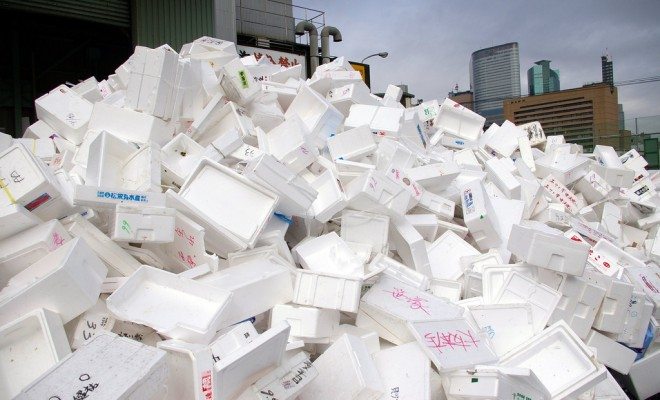 Image courtesy of [David Gilford via Flickr]
Image courtesy of [David Gilford via Flickr]
Energy and Environment
Wave Goodbye to Your Takeout Containers: NYC Bans Styrofoam
On January 8, New York City Mayor Bill de Blasio’s administration finished the work started by previous Mayor Michael Bloomberg by announcing that styrofoam containers will go by the wayside. This includes to-go boxes from the city’s many food trucks as well as coffee cups and packing peanuts. This is a purely environmental move, which might end up costing consumers more money and inconveniencing vendors. Though it has been met with some controversy, most people agree that ultimately it is a good decision.
Expanded Polystyrene Foam, or styrofoam, is one of mankind’s worst inventions. While it’s buoyant properties are desirable for flotation devices and its insulating properties are handy in construction projects, it is non-biodegradable. Thus it sits in landfills forever, never decomposing into the soil. Furthermore, the Department of Sanitation recently determined that it is not recyclable, which played a substantial part in deciding to ban the product. Finally, since most people’s exposure to styrofoam comes in the form of food or beverage containers, it is worth noting that some studies by the EPA suggest a possible mild carcinogenicity.

Courtesy of Jon Hayes via Flickr.
The New York City ban goes into effect on July 1, 2015; however, there will be a six-month grace period before the city begins enforcement so that vendors can seek alternatives. Furthermore, nonprofits and businesses with less than $500,000 in annual income may qualify for an exemption. Finally, while packing peanuts will no longer be sold within the city, packages containing them can still be shipped in. Nonetheless, this determination represents a great step forward in eradicating the material.
Those who support styrofoam do so because it is cheap to acquire and convenient to use; however, there are plenty of alternatives. For example, the city’s Department of Education plans to serve children their food on compostable plates instead. Starbucks and some other coffee companies hand out their products in paper cups with a cardboard ring around them; these are recyclable products that also do a sufficient job of keeping the customer’s hands from being burned. This is a poignant example, because styrofoam is a part of the fashion employed by Dunkin Donuts. In New York, they will have to find a slightly new appearance to compliment the regulations. Customers might worry that their coffee will not stay as hot for as long or will be inconvenienced in other ways.

Courtesy of Erik Sagen via Flickr.
Smaller businesses and vendors are most concerned about the ban because they will likely have to buy more expensive containers. Assuming they can find effective replacements for styrofoam, they will probably have to charge more for what is famously cheap food in order to make up their losses. Up until now it has cost $86 per ton to landfill foam, and $160 to reuse it in some form. These expenses come out of taxpayers’ pockets. Therefore consumers should be okay with paying a slightly higher price for environmentally friendly containers, because it would likely be to their financial benefit in the long run.
Just as with attempting to live off of alternative energy sources, making the transition to environmentally sustainable items and lifestyles is a difficult one. There are likely to be some monetary losses at the outset, but in the long run these things tend to prove to be more financially viable. Environmental sustainability often goes hand in hand with economic sustainability. We should not be afraid to venture outside of our comfort zones and established ways of life in quest of something new and better. Styrofoam is something we take for granted; our morning cup of coffee seems an insignificant thing, but it ends up having a massive impact as it is on a scale of hundreds of millions and of a daily occurrence.

Courtesy of Jonno Witts via Flickr.
These measures will not simply open up space in landfills; an unfortunately large amount of garbage ends up in the water. Especially considering New York City’s geographic orientation, many feel that the styrofoam ban will benefit the local aquatic biodiversity as well as the urban water supply itself. Styrofoam will not yet disappear altogether, but this is a substantial step in the right direction.








Comments